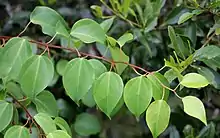Berberidopsis beckleri
Berberidopsis beckleri is a species of climbing plant found in cool rainforests in eastern Australia.[1][2] Ferdinand von Mueller described the plant as Streptothamnus beckleri from collections at the Clarence River.
| Berberidopsis Beckleri | |
|---|---|
 | |
| Dorrigo National Park, Australia | |
| Scientific classification | |
| Kingdom: | Plantae |
| Clade: | Tracheophytes |
| Clade: | Angiosperms |
| Clade: | Eudicots |
| Order: | Berberidopsidales |
| Family: | Berberidopsidaceae |
| Genus: | Berberidopsis |
| Species: | B. beckleri |
| Binomial name | |
| Berberidopsis beckleri | |
| Synonyms | |
| |
Description
The Berberidopsis Beckleri belongs to one of the three species of the family Berberidopsidaceae. The family Berberidopsidaceae belongs with the monotypic Aextoxicaceae to the order Berberidopsidales. This plant, is unusual for the core eudicots because they have been placed in the same order to the divergence of Asterids, Caryophyllales, and Santalales
Morphology
Berberidopsis beckleri is a vine growing. New shoots are produced every year which contribute to the developing of flowers in the axils of leaves before it turns vegetative and producing twining stems.
Flowers
The flowers of Berberidopsis have a spiral phyllotaxis. They don't have a clear way to distinguish the bracts, sepals and petals. The flowers appear separate from anything else and pendent on long pedicels in the axil of an ovate leaf. The contain a progressive loss of red pigmentation from the outside towards the inner perianth parts.
Flowers display a spirally arranged perianth, which increase in size from the bracts to the inner tepals
Petals
The petals are the number of perianth parts including bracts that varies between 13 and 16. They have a truncate apex.
Inner petaloid tepals
The inner petaloid tepals are larger in size than the outer tepal. This tepal creates an urceolate structure which enclose the sexual organs from the plants.
Stamens
The stamens are arranged in a single sequence with filaments which supports the anther. Stamen number varies between 8, 11, and 13. Stamens are surrounded by a crenelated disc nectary.
Ovary
The ovary is the female organ, contains ovule which develops into seeds. Ovary is elliptical, with a massive style and green stigma lobes.
Leaves
The leaves are simple, ovate to broad–ovate, alternate, palmately veined. They are usually 3 cm to 6 cm long. leaves are soft and thin, with a hairy look-like structure in the midvein and lowest veins.
Species
The genus of Berberidopsis has two species:
- Berberidopsis beckleri
Was originally described as Streptothamnus beckleri by Von Mueller, in 1862. However, in 1984 Veldkamp moved the species to Berberidopsis on the basis of strong similarities in seed anatomy, pollen and wood, which are clearly different in Streptothamnus moorei. <<Berberidopsis beckleri>, a montane tape vine of Australia.
- Berberidopsis corallina
Occupies a crucial position in the core eudicots regarding the origin of pentamery and the evolution of a bipartite perianth. They are considered as the coral plant of Chile, a threatened woody vine. The stems are used in traditional basketry by southern Mapuche people.
Distribution
Berberidopsis beckleri is found in Queensland and New South Wales, Australia. With the Australian monotypic genus Streptothamnus, Berberidopsis makes up the family Berberidopsidaceae
Berberidopsis corallina is found in two different countries, which are the Patagonian sections of Chile and Argentina.
Habitat
This kind of plants grow and distribute in cooler Rainforest such as, the north from the Barrington Tops area.
Occurrence
Berbetidopsis beckleri were found for the very first time in three natural parks:
References
[3] [4] [5] [6] [7] [8] [9] [10]
- G.J. Harden. "Berberidopsis beckleri, PlantNET - NSW Flora Online, Retrieved December 3rd, 2017,".
- Department of Environment and Heritage Protection. "Berberidopsis beckleri, Wetland Info, State Government of Queensland, Retrieved December 3rd, 2017,".
- Classen-Bockhoff R, Bull-Hereñu K. 2013. Towards an ontogenetic understanding of inflorescence diversity. Annals of Botany 112: 1523–1542.
- Carlquist S. 2003. Wood anatomy of Aextoxicaceae and Berberidopsidaceae is compatible with their inclusion in Berberidopsidales. Systematic Botany 28: 317–325.
- Angiosperm Phylogeny Group IV. 2016. An update of the angiosperm phylogeny group classification for the orders and families of flowering plants: APG IV. Botanical Journal of the Linnean Society 181: 1–20.
- Doyle JA. 2013. Phylogenetic analyses and morphological innovations in land plants. Annual Plant Reviews 45: 1–50.
- Veldkamp JP. 1984. Berberidopsis (Flacourtiaceae) in Australia. Blumea 30: 21–29.
- van Heel WA. 1984. Flowers and fruits in Flacourtiaceae V. The seed anatomy and pollen morphology of Berberidopsis and Streptothamnus. Blumea 30: 31–37.
- Wanntorp L, Ronse De Craene LP. 2007. Flower development of Meliosma (Sabiaceae) – evidence for multiple origins of pentamery in the eudicots. American Journal of Botany 94: 1828–1836.
- Kubitzki K. 2007. Berberidopsidaceae. In: Kubitzki K, ed. The families and genera of vascular plants , Vol. IX. Berlin: Springer, 33–35.